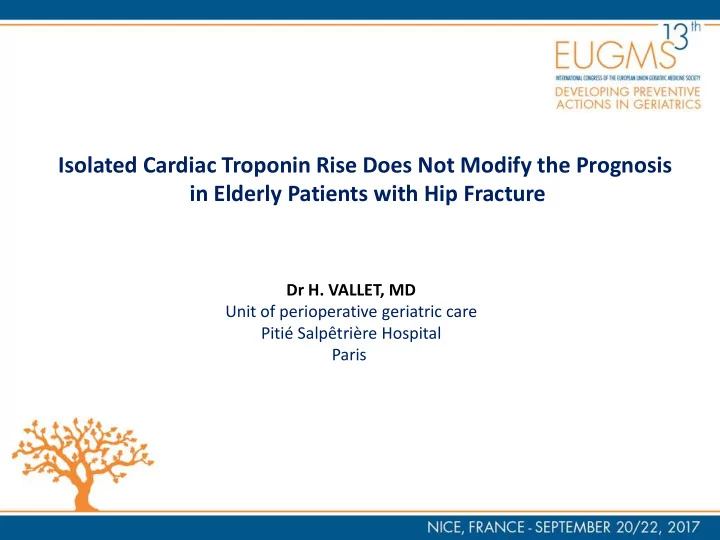

Isolated Cardiac Troponin Rise Does Not Modify the Prognosis in Elderly Patients with Hip Fracture Dr H. VALLET, MD Unit of perioperative geriatric care Pitié Salpêtrière Hospital Paris
CONFLICT OF INTEREST DISCLOSURE I have no potential conflict of interest to report
INTRODUCTION Hip fracture : - frequent geriatric condition (1.6 million patients/year worldwide) - poor prognosis (20-30% one year mortality) notably due to cardio-vascular complications Acute myocardial infarction : Universal definition: troponin elevation in association with electrocardiographic changes, and/or clinical symptoms of ischemia, and/or new wall motion anomalies - frequent post-operative complication notably in non cardiac surgery. - Associate with poor prognosis. - Frequently asymptomatic notably in the elderly population Le Manach et al. Anesthesiology 2005 Thygesen et al. J. Am Coll Cardiol 2012 Brauer et al. JAMA 2009
INTRODUCTION The prognostic significance of a cardiac troponin rise remains controversial in elderly patients with hip fracture. Some studies reported an increase in short and long-term mortality while other did not. Moreover, these studies did not distinguish Isolated troponin rise and myocardial infarction according to the universal definition Chong et al., Age ageing 2009 Fisher et al. Arch Orthop Trauma Surg 2008
INTRODUCTION The aim of our study was to assess the prognostic value of Isolated Troponin Rise (ITR) in elderly patients with hip fracture.
METHODS June 2009-June 2013 in Pitié-Salpêtrière hospital (Paris) Inclusion criteria: - ≥ 70 years of age - hip fracture - post-operative cardiac troponin measurement Exclusion criteria: - multiple or metastatic fractures - redo surgery - no troponin measurement
METHODS All data were prospectively collected (age, sex, CIRS, comorbidity, ADL, IADL etc …) Electrocardiogram (ECG) and cardiac troponin I (cTnI) measurement were routinely performed within the first 3 days after surgery in all patients. Patients were regrouped according to troponin level and ECG interpretation - Control group (no significant ECG change and no troponin rise), - ITR Group (troponin rise without significant ECG changes) - ACS group (troponin rise with significant ECG changes).
METHODS The primary end point: 6 month mortality and/or re-hospitalization Secondary end points: - acute care and/or rehabilitation mortality - Post-operative complications - 30-day readmission - 6 month functional outcome (ability to walk, ADL and IADL) - new institutionalization.
RESULTS
RESULTS Control Isolated Acute coronary P values (n=217) troponin rise syndrome (n=50) (n=45) Age (years) 86±7 87±6 84±9 .09 Men 58 (27) 11 (22) 14 (32) .60 Medical history Atrial fibrillation 50 (23) 12 (24) 14 (31) .52 Coronary artery disease 35 (16) 12 (24) 15 (33)* .02 Cardiac failure 31 (14) 12 (24) 14 (31)* .01 Estimated creatinine clearance < 30 mL/min 21 (10) 15 (30)* 10 (22)* <.001 CIRS 52 8 [6-11] 8 [7-12] 10 [7-13] .07 Autonomy ADL 5 [3-6] 5 [2-6] 5 [4-6] .09 Walking ability No walking disability 125 (58) 26 (52) 15 (33)* .01
RESULTS: primary end point
RESULTS: secondary end points Isolated Acute coronary P values Control troponin rise syndrome (n=217) (n=50) (n=45) Acute care complications Atrial fibrillation 14 (6) 5 (10) 10 (22)* .004 Acute cardiac failure 28 (13) 7 (14) 15 (33)* .002 Stroke 0 (0) 1 (2) 3 (7)* .001 Infection 42 (19) 16 (32) 16 (36) .02 Admission into ICU 5 (2) 3 (6) 7 (16)* <.001 Death during acute care and/or rehabilitation 17 (8) 6 (12) 10 (22)* .02 Return to home 180 (83) 36 (72) 25 (27)* <.001 Readmission within 30 days 11 (5) 0 (0) 7 (17)† .002 At 6 months No walking disability 55 (31) 13 (31) .03 9 (27) * ADL 5 [2-6] 3 [2-5] 3 [1-5]* .03
CONCLUSION Isolated troponin rise - was not predictive of 6-month death and/or re-hospitalization - did not significantly influence any other outcomes - postoperative complications, - admission to ICU - new institutionalization - walking ability and functional status. cTnI rise within the context of ACS - was associated with a significant increase of 6 months death and/or rehospitalization - and a poorer outcome considering - admission to ICU - new institutionalization - walking inability and functional status
RESULTS: secondary end points
Recommend
More recommend